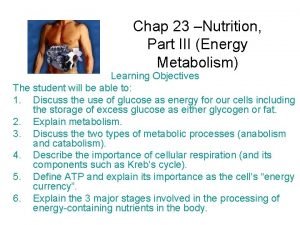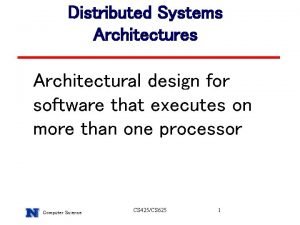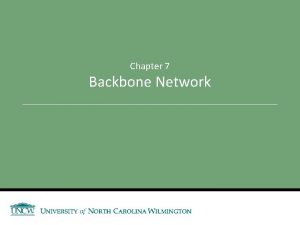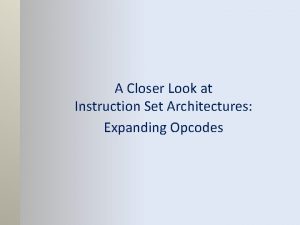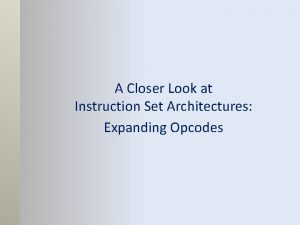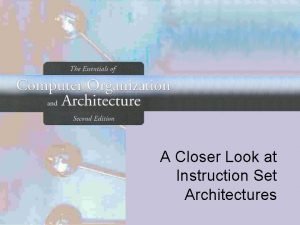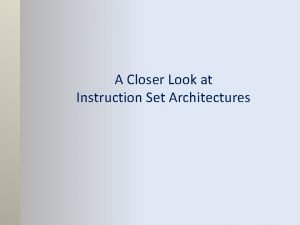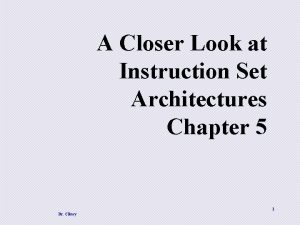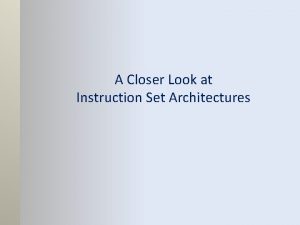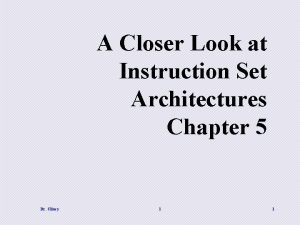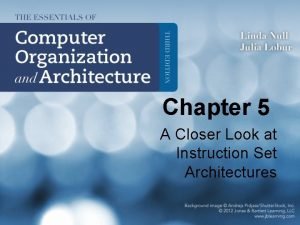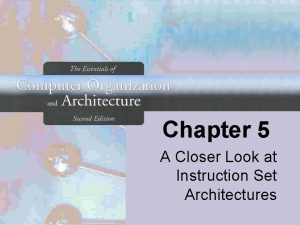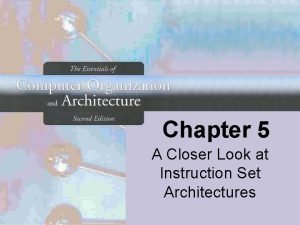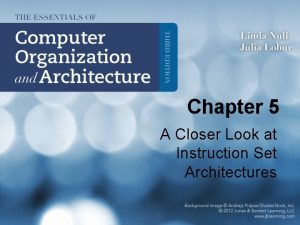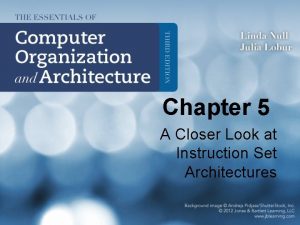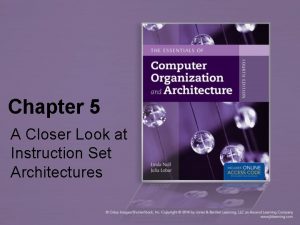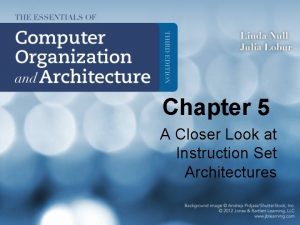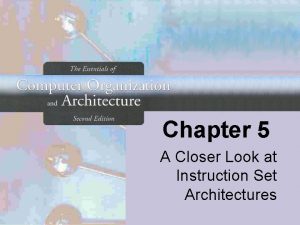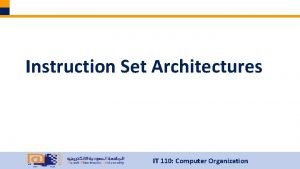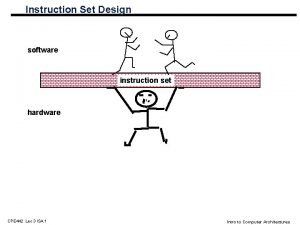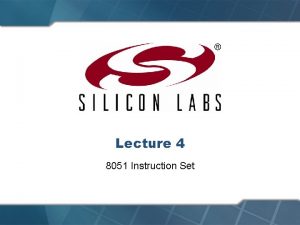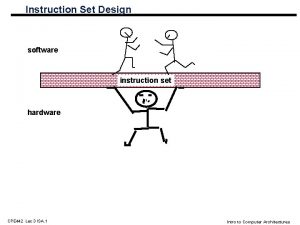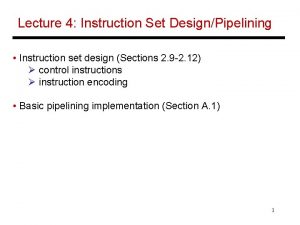A Closer Look at Instruction Set Architectures Expanding



























- Slides: 27

A Closer Look at Instruction Set Architectures: Expanding Opcodes

Lecture Overview § Instruction formats • Expanding Opcodes § Instruction types § Addressing 2

Instruction formats Expanding Opcodes § We have seen how instruction length is affected by the number of operands supported by the ISA. § In any instruction set, not all instructions require the same number of operands. § Operations that require no operands, such as HALT, necessarily waste some space when fixedlength instructions are used. § One way to recover some of this space is to use expanding opcodes. 3

Instruction formats Expanding Opcodes § The idea of expanding opcodes is to make some opcodes short, but have a means to provide longer ones when needed. § When the opcode is short, a lot of bits are left to hold operands • So, we could have two or three operands per instruction § If an instruction has no operands (such as Halt), all the bits can be used for the opcode • Many unique instructions are hence available § In between, there are longer opcodes with fewer operands as well as shorter opcodes with more operands. 4

Instruction formats Expanding Opcodes § Example 1: Consider a machine with 16 -bit instructions and 16 registers. • The instruction format can have several structures: - Opcode + Memory address (such as MARIE): → If we have 4 KB byte addressable memory we need 12 bits to specify an address location → The remaining 4 bits are used for the opcode: 16 instruction are hence available - Opcode + Registers Addresses → we need 4 bits to select one of the 16 available registers → Suppose we have 4 bits opcode, we could encode 16 different instructions with three operands each (3 x 4 bits = 12 bits). 5

Instruction formats Expanding Opcodes § Example 2: Consider a machine with 16 -bit instructions and 16 registers. And we wish to encode the following instructions: - 15 instructions with 3 addresses 14 instructions with 2 addresses 31 instructions with 1 address 16 instructions with 0 addresses Can we encode this instruction set in 16 bits? • Answer: Yes if we use expanding opcodes 6

Instruction formats Expanding Opcodes § One possible encoding is as follows: Is there something missing from this instruction set? 7

Instruction formats Expanding Opcodes § How do we know if the instruction set we want is possible when using expanding opcodes? • We must determine if we have enough bits to create the desired number of bits patterns 8

Instruction formats Expanding Opcodes § Going back to Example 2 (Slide 6): • The first 15 instructions account for: 15 x 24 x 24 = 15 x 212 = 61440 bit patterns • The next 14 instructions account for: 14 x 24 = 15 x 28 = 3584 bit patterns • The next 31 instructions account for: 31 x 24 = 496 bit patterns • • • The last 16 instructions account for 16 bit patterns In total we need 61440 + 3584 + 496 + 16 = 65536 different bit patterns Having a total of 16 bits we can create 216 = 65536 bit patterns We have an exact match with no wasted patterns. So our instruction set is possible. 9

Instruction formats Expanding Opcodes § Example 3: Is it possible to design an expanding opcode to allow the following to be encoded with a 12 -bit instruction? Assume a register operand requires 3 bits. • 4 instructions with 3 registers • 255 instructions with 1 register • 16 instructions with 0 register 10

Instruction formats Expanding Opcodes § Solution: • The first 4 instructions account for: - 4 x 23 x 23 = 4 x 29 = 2048 bit patterns • The next 255 instructions account for: - 255 x 23= 2040 bit patterns • The last 16 instructions account for 16 bit patterns • In total we need 2048 + 2040 + 16 = 4104 bit patterns • With 12 bit instruction we can only have 212 = 4096 bit patterns • Required bit patterns (4104) is more than what we have (4096), so this instruction set is not possible with only 12 bits. 11

Lecture Overview § Instruction formats § Expanding Opcodes § Instruction types § Addressing 12

Instruction types § Instructions fall into several broad categories: • Data movement instructions - The most frequently used instructions - Data is moved from memory into registers, from registers to registers, and from registers to memory - Examples: Load, Store, Move, Push, Pop, etc. • Arithmetic instructions - Include those instructions that use integers and floating point numbers. - As with the data movement instructions, there are sometimes different instructions for providing various combinations of register and memory accesses in different addressing modes. - Examples: Add, Subtract, Multiply, Increment, Decrement, etc. 13

Instruction types § Instructions fall into several broad categories: • Boolean Instructions - Perform Boolean expressions. - Commonly used to control I/O devices. - Examples: Not, Or, Xor, Test, compare, etc. • Bit manipulation instructions - Used for setting and resetting individual bits (or sometimes groups of bits) within a given data word. - Examples: Shift left, shift right, rotate left, rotate right 14

Instruction types § Instructions fall into several broad categories: • I/O instructions - Used to communicate with input/output devices - Examples: Input, Output. • Control transfer Instructions - Include branches, skips and procedure calls. - Examples: For MARIE we have Jump, skipcond and Jn. S. • Special purpose Instructions - Include those used for string processing, high-level language support, protection, flag control, and cache management. 15

Instruction types § When designing an instruction set for a given architecture, we must respect the following: • Create a complete instruction set. • Be carful not to add redundant instructions • We should respect instructions orthogonality - Each instruction should perform a unique function without duplicating any other instruction 16

Lecture Overview § Instruction formats § Expanding Opcodes § Addressing • Introduction • Addressing Modes 17

Addressing - Introduction § Addressing modes specify where an operand is located. § They can specify a constant, a register, or a memory location. § The actual location of an operand is its effective address. § Certain addressing modes allow us to determine the address of an operand dynamically. 18

Addressing Modes § Immediate addressing • The data is part of the instruction. • Example: Load 008 - The numeric value 8 is loaded into the AC § Direct addressing • The address of the data is given in the instruction. • Example: Load 008 - The data value found at memory address 008 is loaded into the AC § Register addressing • The data is located in a register. • Example: Load R 1. - The contents of R 1 register is used as the operand. 19

Addressing Modes § Indirect addressing • Gives the address of the data in the instruction. • Example Load 008 - The data value found at memory address 008 is actually the effective address of the desired operand. →Suppose we find the value 2 A 0 stored in location 008. → 2 A 0 is the “real” address of he value we want. →The value found at location 2 A 0 is then loaded into the AC 20

Addressing Modes § Register indirect addressing • Uses a register to store the effective address of the data. • Works exactly the same way as indirect addressing mode, except it uses a register instead of a memory address to point to the data. • Example: Load R 1 - The effective address of the desired operand is found in R 1. 21

Addressing Modes § Indexed addressing • uses a register (implicitly or explicitly) as an offset, which is added to the address in the operand to determine the effective address of the data. • Example: Load X, where the index register holds the value 1. - The effective address of the operand in actually X + 1 22

Addressing Modes § Based addressing • Similar to indexed addressing except that a base register is used instead of an index register. • An index register holds an offset relative to the address given in the instruction, but a base register holds a base address where the address field represents a displacement from this base. • Example: Load 3, where the base register holds the address value X. - The effective address of the operand is actually X +3 § Stack addressing • The operand is assumed to be on top of the stack. 23

Addressing Modes § Example: For the instruction shown, what value is loaded into the accumulator for each addressing mode? 800 24

Addressing Modes § Example: For the instruction shown, what value is loaded into the accumulator for each addressing mode? 800 900 25

Addressing Modes § Example: For the instruction shown, what value is loaded into the accumulator for each addressing mode? 800 900 1000 26

Addressing Modes § Example: For the instruction shown, what value is loaded into the accumulator for each addressing mode? 800 + 800 = 1600 800 900 1000 700 27
 Types of isa in computer architecture
Types of isa in computer architecture Look down to the right
Look down to the right Chapter 7 a closer look energy metabolism pathways
Chapter 7 a closer look energy metabolism pathways A closer look at thanksgiving
A closer look at thanksgiving Prophase ii
Prophase ii Look closer see me
Look closer see me Chapter 7 a closer look energy metabolism pathways
Chapter 7 a closer look energy metabolism pathways Total set awareness set consideration set
Total set awareness set consideration set Training set validation set test set
Training set validation set test set Differentiated instruction vs individualized instruction
Differentiated instruction vs individualized instruction Direct instruction vs indirect instruction
Direct instruction vs indirect instruction Database storage architecture
Database storage architecture Banking system architecture diagram
Banking system architecture diagram Integral product architecture
Integral product architecture Aaron bannert
Aaron bannert Base system architectures
Base system architectures Backbone network architectures
Backbone network architectures Gui architectures
Gui architectures Independent data mart architecture
Independent data mart architecture Autoencoders
Autoencoders Switched backbone networks
Switched backbone networks Cache coherence for gpu architectures
Cache coherence for gpu architectures Database system architectures
Database system architectures Integral architecture example
Integral architecture example E-commerce architecture
E-commerce architecture George schlossnagle
George schlossnagle Why systolic architectures
Why systolic architectures Cdn architectures
Cdn architectures


